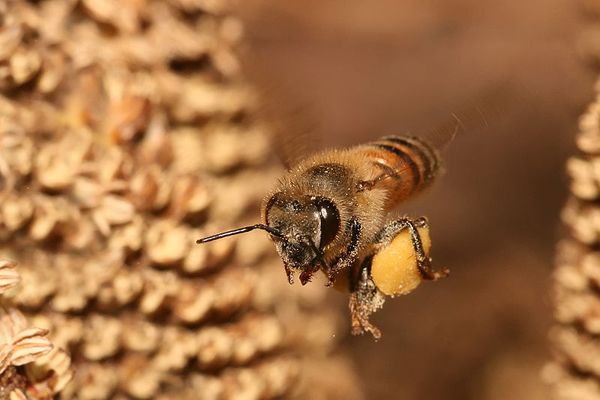Why Are So Many Bee-Carrying Trucks Crashing?

A semi-trailer truck hauling 460 beehives overturned Sunday afternoon on an interstate near St. George, Utah, releasing a swarm of 25 million bees into the air. Several people were stung, including the truck driver, his passenger and those helping out at the scene of the accident.
"It was insane," Corey Jennings, an onlooker who was stung by the bees, told The St. George Daily Spectrum. "The swarm of them was so big. You couldn't see anything else."
A similar incident happened in July, when 14 million bees, as well as a river of honey, flowed out of a wrecked semi in Idaho, and 17 million bees escaped a fatal truck crash in Minnesota last year. Why so many highway accidents involving bees?
The uptick results from the fact that more and more honey bee colonies are being transported around the country via highways in recent years. Local bee populations are rapidly dying off from a little-understood disease called "colony collapse disorder" (CCD), which is marked by one tell-tale sign: When beekeepers open a hive in the spring, they find only the live queen, her brood, and the honey that the bees had stored up for the winter; all the adult bees, and even their carcasses, have mysteriously disappeared.
The nation's beekeepers have reported a loss of around 30 percent of their hives to CCD each year since 2006, and so more and more commercial bee colonies are being trucked cross-country from farm to farm to play the vital role of pollinating crops — especially nuts, berries, fruits and vegetables.
"The number of managed honey bee colonies [in the U.S.] has dropped from 5 million in the 1940s to only 2.5 million today. At the same time, the call for hives to supply pollination service has continued to climb. This means honey bee colonies are trucked farther and more often than ever before," the U.S. Dept. of Agriculture states on its website.
Unfortunately, some apiologists — honey bee scientists — suspect that the rise of the bee-trucking industry may be contributing to the species' decline. A United Nations study from earlier this year found that industrialized hives create ideal breeding conditions for the pathogens and fungal diseases that may be killing the bees. Transporting the hives from farm to farm then spreads the pathogens to local bee populations.
Sign up for the Live Science daily newsletter now
Get the world’s most fascinating discoveries delivered straight to your inbox.
Researchers are concerned that the loss of pollinators could eventually lead to food shortages. According to the U.N., 70 percent of the 100 crop species that provide 90 percent of the world's food are pollinated by bees.
- 10 Species You Can Kiss Goodbye
- Bees' Beelines Could Yield Faster Internet
- Sex-Crazed Insects Whip Up 'Bugnadoes' In Iowa
This article was provided by Life's Little Mysteries, a sister site to LiveScience. Follow us on Twitter @llmysteries, then join us on Facebook. Follow Natalie Wolchover on Twitter @nattyover.
Natalie Wolchover was a staff writer for Live Science from 2010 to 2012 and is currently a senior physics writer and editor for Quanta Magazine. She holds a bachelor's degree in physics from Tufts University and has studied physics at the University of California, Berkeley. Along with the staff of Quanta, Wolchover won the 2022 Pulitzer Prize for explanatory writing for her work on the building of the James Webb Space Telescope. Her work has also appeared in the The Best American Science and Nature Writing and The Best Writing on Mathematics, Nature, The New Yorker and Popular Science. She was the 2016 winner of the Evert Clark/Seth Payne Award, an annual prize for young science journalists, as well as the winner of the 2017 Science Communication Award for the American Institute of Physics.
Most Popular

